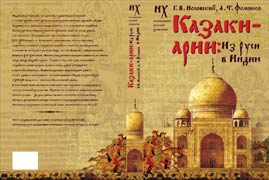 Publishing house AST-ASTREL, Moscow, 2007.
Publishing house AST-ASTREL, Moscow, 2007.
CONTENTS
Part 1.
WHEN THE FAMOUS EPOSES "MAHABHARATA" AND "RAMAYANA" WERE CREATED AND WHAT THEY TELL ABOUT.
1. The Scaligerian chronology of India.
2. The Scaligerian history of the Mahabharata and the Ramayana.
2.1. The Mahabharata.
2.2. The Ramayana.
2.3. The god Krishna – it is, probably, a reflection of Jesus Christ in the Indian holy texts.
3. The famous Aryans, about whom the Mahabharata and the Ramayana tell, came to the semi-island Hindustan from the North. These were Cossacks-Hordians of the XIV century.
3.1. "The tale about Rama" or "The Small Ramayana" in "The Mahabharata" tells about colonization of India by the Aryans.
3.2. The bright traces of the North origin of the Aryans, which remained in the Mahabharata.
4. The great Battle of Kulikovo of 1380 is described in "the ancient" Mahabharata as the great battle on the Kuru field.
4.1. A short contents of the epos.
4.2. The book of Bhagavadgita.
4.3. Events before the beginning of the battle on the Kuru field, according to Bhagavadgita. The Kuru field – it is the Kulikovo field. Arjuna – it is Dmitry Donskoy. Duryodhana – it is Khan Mamay.
4.4. The battle on the Kuru field (Kurukshetra = Kulak+Zhertva?). A fail of the troops of Duryodhana (Bad Khan?) and his death. Deploration and burying of the fallen.
4.5. "An Attack on the Sleeping", described in the Mahabharata, it is an attack of the Hordians on the army of Nizhny Novgorod on the river Pyanaya in 1377.
4.6. Guns on the fields of the "ancient"-Indian battles, in particular, - on the Kuru battle field (Kurukshetra).
4.7. "The Indian staffs" – these are fire muskets or musketoons, small portable guns.
4.8. The war wagons, described in the Mahabharata, these are, probably, guns.
4.9. The Battle of Kulikovo was a battle for taking Christianity as a single state religion in the entire huge "Mongol" Empire.
5. Biblical events of the XV-XVI centuries on the pages of the Mahabharata.
5.1. The flood and floating of patriarch Noah-Manu across the ocean in the XV century.
5.2. The Biblical exodus of Moses of the XV century on the pages of the Mahabharata.
5.3. The Biblical story of Esther of the XVI century on the pages of the Mahabharata.
5.4. The story of Esther in "the ancient" Babylon epos.
5.5. The story of Biblical Susanne – one more reflection of Esther, - is also described in the Mahabharata.
6. The evangelic motives on the pages of the Mahabharata.
6.1. A Virgin Birth, Holy Mary. Indian god-human Yudhishthira as a reflection of Christ.
6.2. The intrigues of tsar Herod against Christ. The Holy Family saves, running to Egypt. A return of Christ to Jerusalem. The Flagellation of Christ.
6.3. The ascension of Christ on the Calvary. Praying in the garden of Gethsemane. The sleeping of apostles.
6.4. Ascension of Christ to heaven is described in the Mahabharata. Yudhishthira as a Savior.
6.5. The Descend of Christ to hell on the pages of the Indian Epos.
6.6. Some other places from the Bible, reflected in the Mahabharata.
7. A developed astronomy on the pages of the Mahabharata indicates a medieval origin of the Epos.
8. Additional parallelisms between Mahabharata and European medieval events.
8.1. Where the Aryans=Yurians saw a volcano?
8.2. St. Augustin and Jesus Christ on the pages of the Mahabharata.
8.3. A Ukrainian custom in the Mahabharata.
8.4. Presbyter John.
8.5. The blue eyes of the Aryans=Yurians.
8.6. A cock – a symbol of fire and war.
8.7. A sacrificial offering of a horse, made by the Skythians and Aryans.
8.8. Boncuks of the Cossacks and boncucks of the Indian Kshatriya.
8.9. The right side and the left side.
8.10. The famous Indian soma – a drink of gods – probably got its name from Russian "sam".
8.11. Lotus and Liliales in general as religious symbols in the Mahabharata.
9. The famous "Book of Volos", probably, comes up to the Indian Epos about the conquest of India by Aryans=Yurians in the XIV-XV centuries.
10. Conclusion.
11. Additional parallels between the Russian language and Sanskrit, taken out from the Mahabharata.
Part 2.
"THE SHIP OF FOOLS" AND THE REBEL OF REFORMATION. MISCELLANEOUS.
1. "Antique" Skythian Ivanko Tarul of 1748 A.D.
2. At the epoch of Reformation the image of "The Ship of Fools" was created and promoted; and all the Western Europe had been made laughing at it. The reformers laughed at the Great = "Mongol" Empire.
3. In the XVI-XVII centuries some points of the Biblical history looked not like in the famous today canon of the Bible.
4. Changes of the Christian cross, which appeared after the XII century.
5. Irish sea tales - "The Floating of St. Breanainn", "The Life of St. Columbanus" and others, related by historians to the VI century A.D., actually tell about the floating of Columbus in 1492.
6. Some historians, responding to our new chronology, try to argue against the true statements of the Russian chronicles about the Battle of Kulikovo, which became "very unpleasant" to them.
LITERATURE.
About the authors.
Signatures to drawings